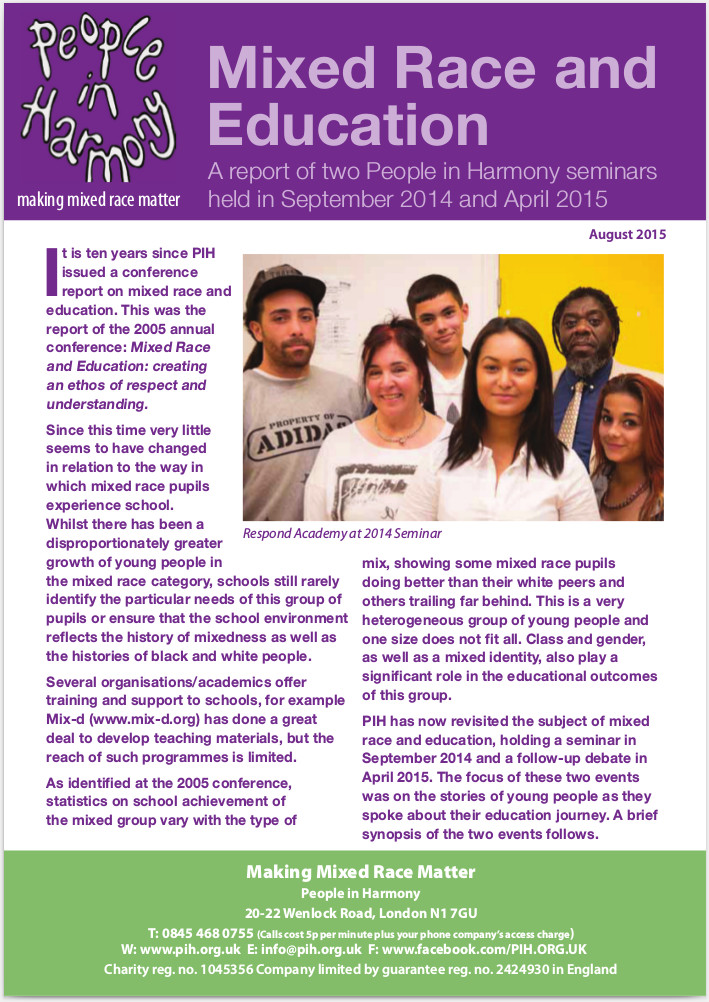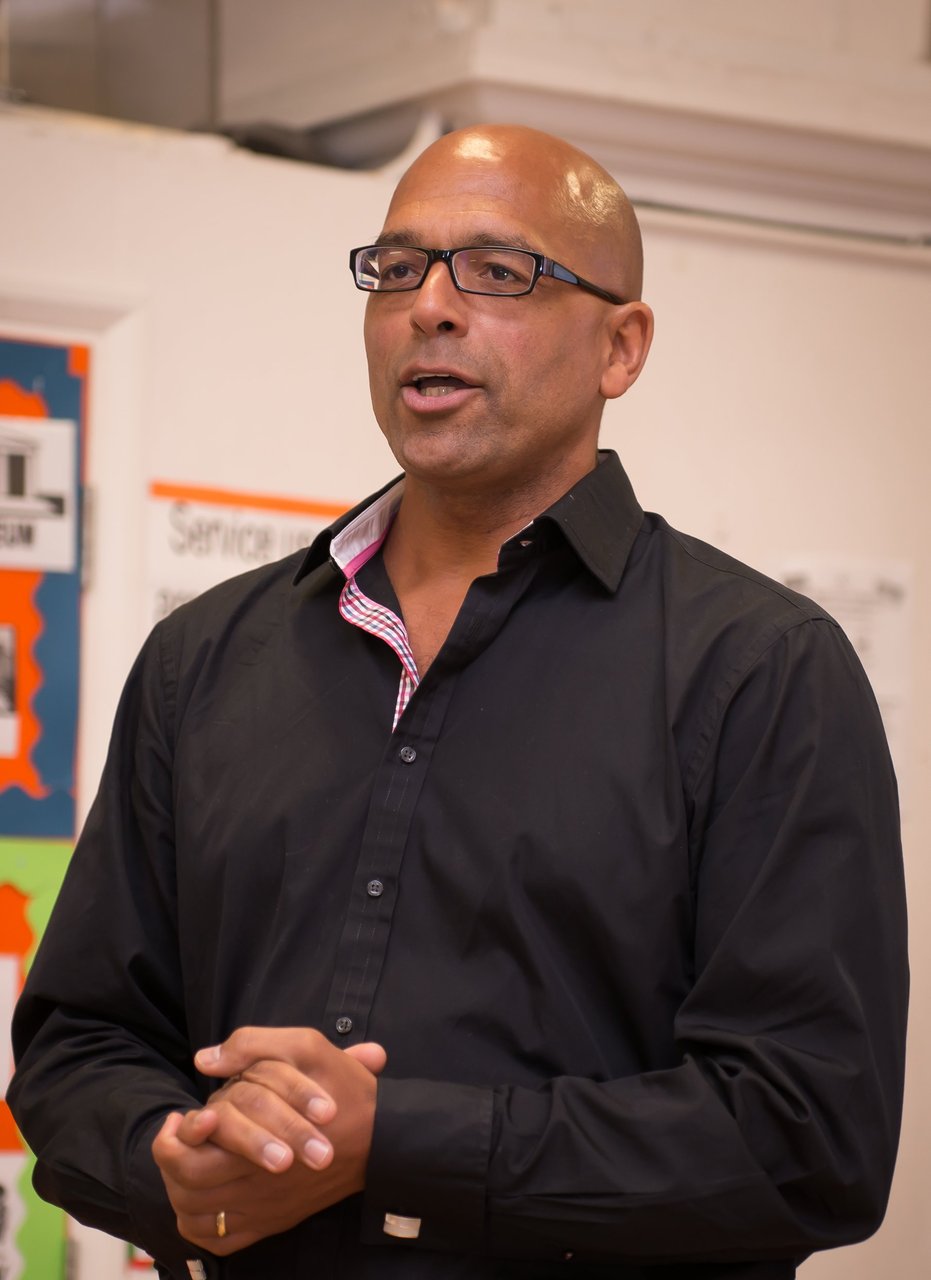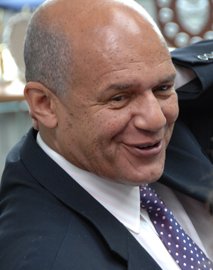PIH Mixed Race and Education Report 2015
It is ten years since People in Harmony (PIH) published “Mixed Race and Education: creating an ethos of respect and understanding”, a conference report on mixed race children and young people in the education system. PIH has now revisited the subject of mixed race young people in education in order to consider ways in which a better dialogue with schools could be achieved to help improve outcomes to add some substance to a patchy body of research.
 Whilst the family plays a crucial role in building a sense of identity and resilience for a young person of mixed race, outside the home the experience of school has a huge impact on a their personal development. During a child’s early school years, ideas of identity and race are less firmly fixed and although young children from black and minority ethnic groups, including those of mixed race, are racially taunted the impact is usually not experienced as other than playground insults.
Whilst the family plays a crucial role in building a sense of identity and resilience for a young person of mixed race, outside the home the experience of school has a huge impact on a their personal development. During a child’s early school years, ideas of identity and race are less firmly fixed and although young children from black and minority ethnic groups, including those of mixed race, are racially taunted the impact is usually not experienced as other than playground insults.
This changes as young people enter secondary school and, as they approach adolescence, there are new challenges to navigate and identities to form. For some young people this may be the first time they have to deal with explicit racism. Being part of a peer group during adolescence is especially important. For a mixed race child this can be a frustrating and confusing time as they may find themselves shut out of the group by friends from an earlier age because they are ‘too black to be white, too white to be black.’
In 2013 a report showed Mixed Black Caribbean/White pupils in Reading schools* as being disadvantaged at 5 years old and make less progress in secondary school than similar pupils nationally; that they are more likely than other pupils in Reading to be identified as having special educational needs; they are at higher risk of exclusion than pupils from other ethnic groups and are at a higher risk of exclusion than pupils of the same ethnic background nationally. The paper considered local data to highlight the need for Reading schools to take action on these issues.
The number of UK residents claiming mixed ethnicity is rising sharply. The 2011 census revealed that the UK's ethnic-minority population has grown from 9 per cent to 14 per cent since 2001 with the numbers of mixed race young people increasing from 677,117 to 1,224,400. While there has been a huge growth in the numbers of young people of mixed race, schools still rarely identify the particular needs of this group of pupils or ensure that the school environment reflects the history of mixedness as well as the histories of black and white people.
As identified by our 2005 conference report, statistics on the educational achievement and experiences of pupils who are mixed race vary widely with the type of mix. Some statistics show mixed race pupils doing better than their white peers while others show them trailing far behind. Class and gender also play significant roles in the educational outcomes of this very heterogeneous group of young people and one size does not fit all.
 This PIH Mixed Race & Education 2015 report is based on a seminar in 2014 and follow up debate in 2015. These two events focussed on the stories of young people speaking about their educational journeys with Clive Webster, a mixed race education expert and schools academies’ director, also talking about his experiences. Maintaining high expectations of himself enabled him to navigate the sometimes negative experiences of being a mixed race person in the education system and enabled him to attain the top positions and career that he now enjoys.
This PIH Mixed Race & Education 2015 report is based on a seminar in 2014 and follow up debate in 2015. These two events focussed on the stories of young people speaking about their educational journeys with Clive Webster, a mixed race education expert and schools academies’ director, also talking about his experiences. Maintaining high expectations of himself enabled him to navigate the sometimes negative experiences of being a mixed race person in the education system and enabled him to attain the top positions and career that he now enjoys.
 Sir Keith Ajegbo, a mixed race ex headteacher, leadership manager and trustee of the Stephen Lawrence Foundation also spoke. He highlighted the importance of organisations like PIH working more with universities and students to promote much needed research into the changing experiences of being mixed race and British. He also stressed the need to use the lived experiences of those participating in the seminar to make recommendations to teachers so they could better target and deal with key issues affecting mixed race students.
Sir Keith Ajegbo, a mixed race ex headteacher, leadership manager and trustee of the Stephen Lawrence Foundation also spoke. He highlighted the importance of organisations like PIH working more with universities and students to promote much needed research into the changing experiences of being mixed race and British. He also stressed the need to use the lived experiences of those participating in the seminar to make recommendations to teachers so they could better target and deal with key issues affecting mixed race students.
Young mixed race people from the Respond Academy in Hastings spoke of their experiences in the school system. One of the key issues they raised was the continuing use of disparaging and derogatory terms to describe mixed race identity. What they said demonstrated a lack of awareness amongst teachers and others in schools of mixed race issues and the subsequent lack of support for mixed race pupils. Their experiences also highlighted the fact that young people want to select their own ways of describing their identity with words they are comfortable with.
FREE DOWNLOAD PIH Mixed Race & Education 2015 Report pdf
*http://www.school-portal.co.uk/GroupDownloadFile.asp?ResourceId=4823394